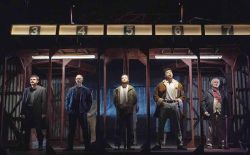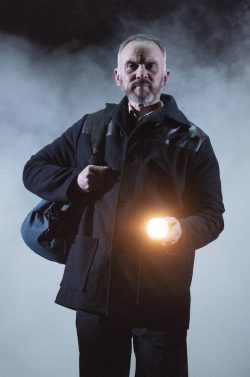 THERE was a running joke in my family, and the younger members regularly pulled my maternal grandfather’s leg, that as a lifelong trade unionist he was still fighting the General Strike 50 years after the event. Looking at Alan Bleasdale’s Boys from the Blackstuff, 40 years after it first appeared on BBC 2, adapted for the stage by James Graham, I have the feeling that he, like my Grandfather with the General Strike, is still as angry and unforgiving about Thatcherism, which he believes was behind so much of the suffering caused by the loss of mining, heavy industry and manufacturing, in the 1980s.
THERE was a running joke in my family, and the younger members regularly pulled my maternal grandfather’s leg, that as a lifelong trade unionist he was still fighting the General Strike 50 years after the event. Looking at Alan Bleasdale’s Boys from the Blackstuff, 40 years after it first appeared on BBC 2, adapted for the stage by James Graham, I have the feeling that he, like my Grandfather with the General Strike, is still as angry and unforgiving about Thatcherism, which he believes was behind so much of the suffering caused by the loss of mining, heavy industry and manufacturing, in the 1980s.
Naturally, with the loss of so many jobs in these industries – at one time in the 1980s, there were more than three million unemployed in the UK – there was a knock-on effect. It is through the eyes of a group of unemployed, and for all their efforts apparently unemployable, building workers, that we are shown the bleak world, with little hope for the future, that they existed in.
 Under gritty direction by Kate Wasserberg, we see how even the work-at-all-cost, even if it is the humiliation of “moonlighting”, Mark Womack’s beautifully crafted Dixie is coming to the end of his tether. George Caple’s Chrissie is just as angry and frustrated by the officious attitude they encounter at the Employment Exchange, but his moral views deny him the luxury of compromise. With wife and children gone, Jay Johnson’s neurotic, almost psychopathic Yosser is already on the verge of a breakdown as he fantasises with everyone he meets, from a school crossing lollipop lady to a Church of England vicar – “I could do that. Gizza job”.
Under gritty direction by Kate Wasserberg, we see how even the work-at-all-cost, even if it is the humiliation of “moonlighting”, Mark Womack’s beautifully crafted Dixie is coming to the end of his tether. George Caple’s Chrissie is just as angry and frustrated by the officious attitude they encounter at the Employment Exchange, but his moral views deny him the luxury of compromise. With wife and children gone, Jay Johnson’s neurotic, almost psychopathic Yosser is already on the verge of a breakdown as he fantasises with everyone he meets, from a school crossing lollipop lady to a Church of England vicar – “I could do that. Gizza job”.
 Tragedy is all that awaits Reiss Barber’s Snowy, forced to chance his arm on an unofficial, insecure building site. Ged McKenna never slipped into sentimentality in his portrait of dying elder statesman George.
Tragedy is all that awaits Reiss Barber’s Snowy, forced to chance his arm on an unofficial, insecure building site. Ged McKenna never slipped into sentimentality in his portrait of dying elder statesman George.
While that quintet would never leave Liverpool, with no family ties, Jurell Carter’s Loggo and Kyle Harrison-Pope, as Dixie’s more adventurous son Kevin, are quite willing to take the advice of Thatcherite minister Norman Tebbit to “get on their bikes” and look for work elsewhere. Sean Kingsley convincingly hoovers up seven supporting roles, ranging from a dubious builder to a Catholic priest. In comparison, Jamie Peacock only has to create five characters, but one of them, the ambitious local government man, bent on promotion and quite willing to sacrifice the unemployed on the way, is a truly evil character.
Which leaves Amber Blease and Sian Polhill-Thomas to cover the nine women who are so crucial to the development of the story. The way in which Amber moves from frustrated fury at Chrissie’s refusal to compromise, to comforting him in his distress, spoke volumes for the characters’ relationship. Sian went from frantic housewife valiantly holding the fort against all-comers, to a lovely portrayal of a local government officer tied down with red tape, but with an understanding heart.
Although there is a slight iconic lift at the end, with hope for the future, this is by and large a bleak tale, with the hint that the author is warning us that another recession could be just around the corner.
GRP
Photographs by Alastair Muir